
Expert uses public administration and business management principles to create framework for good governance.
Considering the far-reaching authority of modern government, achieving excellence in regulation can dramatically help the economy and society. After all, regulation touches the lives of everyone and influences business practices in sectors as diverse as medical care, automobile manufacturing, and food production.
Yet, how exactly can regulators achieve excellence in their work?
In his chapter of the recent book, Achieving Regulatory Excellence, Daniel C. Esty, professor of environmental law and policy at Yale Law School, presents lessons regulators can take from business management to improve their performance.
Esty, the former commissioner of Connecticut’s Department of Energy and Environmental Protection (DEEP), observes that the private sector has devoted a great deal of attention to managerial excellence. Esty argues that government regulators can apply these same core principles to their own work.
For example, a company’s managers will spend a considerable amount of time and resources defining their organization’s “vision”—its mission, core values, future direction, goals, and strategy. A clear vision helps ensure that a company is directed by strong leadership that can sharply focus the work of the organization, Esty explains.
Reflecting on what he accomplished while leading Connecticut’s DEEP, Esty argues that part of his success at the agency can be attributed to the clear vision he articulated for the organization. Observing that government organizations are often resistant to potentially valuable innovation, he prioritized process transformation. Borrowing ideas from the world of manufacturing, he worked to streamline and improve the agency’s activities and processes, despite limited staff and even in the wake of budget cuts.
Similarly, almost all sets of core principles for business management will prioritize sound execution of a well-developed strategy to deliver on clear performance targets. Esty argues that the government must also prioritize implementation of regulatory goals, with a focus on delivering greater efficiency, which he defines as reducing the regulatory burden without lowering the agency’s standards.
Esty explains that, at DEEP, he implemented a strategy that invested new resources in staff training and technology upgrades, which helped ensure “buy-in” by the regulatory staff. This alignment between staff and agency goals, Esty argues, contributed greatly to the efficiency successes that DEEP saw during his tenure.
And moving beyond established principles for success in business, Esty provides additional facets of regulatory excellence that build on his own government experience.
For instance, Esty emphasizes the importance of what he calls “integration.” He contends that regulators often think about the cost-benefit analysis for a policy decision in “siloed” terms—that is, considering only the most immediate costs and benefits when doing the required calculation.
Esty points to examples from the U.S. Environmental Protection Agency (EPA) to illustrate siloed thinking. He observes that, to reduce vehicle emissions in the 1990s, EPA required gasoline producers to add a chemical to the fuel that would produce cleaner combustion and thus reducing air pollution, only to find later that the additive caused severe water pollution. EPA could have avoided this pitfall had it integrated all the relevant costs and benefits into its decision making about its air pollution regulation, Esty suggests. Regulators need to take full account of potential countervailing risks and impacts when pursuing a policy goal.
Esty explains how he implemented the integration principle at DEEP by recharacterizing the agency’s mission under a revised, internally used acronym for the department: “DEEEP.” The three “e’s” indicated a commitment not only to energy and the environment, but also to the economy. Esty understood that the public’s tolerance for regulatory programs and adherence to regulatory constraints would often be measured with the costs of administration and compliance.
Esty integrated cost-benefit analysis into DEEP by doing an across-the-board review of the agency’s regulations, which led the department to lower regulatory compliance costs. Moreover, he worked with his agency management team to identify and repeal outdated, duplicative, and other unneeded regulations, which further streamlined the process for private actors. By showing a sensitivity to the state’s economic growth, Esty argues, the regulated community became more willing to accept the costs that his department’s regulations imposed, and they showed far more willingness to work with DEEP to accomplish the agency’s goals.
Esty goes further to delineate several other principles of regulatory excellence, such as the importance of innovation, incentives, and investment. Throughout his chapter, he uses his experience at the helm of DEEP to illustrate how concepts borrowed from the business sector can provide a roadmap for the achievement of regulatory excellence.
The book, Achieving Regulatory Excellence, was edited by University of Pennsylvania Law School Professor Cary Coglianese, who serves as the director of the Penn Program on Regulation.
This essay is part of a ten-part series, entitled In Pursuit of Regulatory Excellence.



